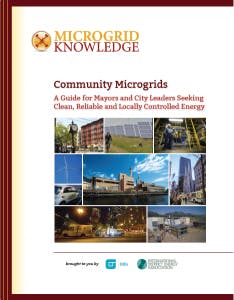What Community Microgrids Offer to North American Cities and Towns
Recent storms and power outages have accelerated the trend, as has the realization among local officials that developing local energy can help municipalities:
▶▶ Keep the lights on when the central grid fails
▶▶ Gain more control over energy costs
▶▶ Better compete for sought-after industries and jobs
▶▶ Improve air quality and achieve climate change goals
▶▶ Improve energy efficiency and incorporate solar, wind and other renewable energy
Community microgrids are central pillars of today’s local energy revolution. Being developed in municipalities large and small, they are a key feature of the new clean and efficient electrical infrastructure that is beginning to transform America’s energy grid into a less centralized and more democratized entity.
Mayors and city leaders are especially tuned into this transformation because of the severe stress that extended power outages create in their communities — from inconveniences that prevent people from completing day-to-day tasks to true threats to health and well-being.
Source: “Economic Benefits of Increasing Electric Resilience,” Executive Office of the President.
Power outages also directly affect commerce and therefore municipal budgets. The U.S. economy pays a high price for power outages — as much $75 billion annually, according to the White House.
Voters tend to hold city leaders accountable when prolonged outages occur, although it is private investor-owned utilities — which serve nearly 70 percent of the U.S. electricity customers — that are typically responsible for power restoration. Due to consolidation in the utility industry in recent years, these private utilities may be based in other cities or states, and possibly governed by international parent companies. Contrary to voter perception, municipal officials actually have little control over the timeliness of power restoration.
Community microgrids, however, offer towns and cities a way to keep the lights on even when the central grid fails, and provide basic services to the citizenry. Power outages are one reason that mayors and municipal leaders seek ways to bring energy production closer to home with microgrids. But the value of the community microgrid goes deeper; a microgrid may not only deter economic calamity, but also can enhance community prosperity. Community microgrids help draw coveted high tech industries to cities and towns by offering the reliable, premium power and cleaner energy services that these businesses require.
In addition, many communities are seeking proven approaches to address climate adaptation; reduce greenhouse gas emissions; and invest in cleaner, more sustainable energy systems. Across the globe, cities large and small are taking initiative to tap local energy resources and build energy infrastructure that will expand their tax base, diversify energy supplies and address the need for expanded services for denser urban populations. Cities are seeing dramatic population growth along with a need for energy master planning and integrated energy systems that optimize efficiency and reduce waste.
Credit: Veolia North America
Why this guide now
While towns and cities show increasing interest in community microgrids — and several have projects under development — little easily accessible guidance exists for municipal leaders who are exploring the concept. To help these communities get started, MicrogridKnowledge.com has produced this report, “Community Microgrids: A Guide for Mayors and City Leaders Seeking Clean, Reliable and Locally Controlled Energy,” the third in our Think Microgrid series.
In this guide, we describe how microgrids serve communities and explain why states like California, Massachusetts and New York promote their development, and offer substantial incentives to boost the industry.
We also detail the key features of a community microgrids, how they work, the value of incorporating both electricity and heat into a project, and why microgrids foster development of renewable energy. We identify steps for cities and towns to take as they begin to develop a project, and discuss various finance options and incentives. Finally, we provide examples of communities that are already benefiting from community microgrids, and others well on their way.
As city and town leaders are well aware, electricity is essential to a functioning society, more so now than ever before as almost all aspects of our economy become Internet-based. We invite you to read on to learn more about how microgrids can protect vital energy supply to your community.
“Community Microgrids: A Guide for Mayors and City Leaders Seeking Clean, Reliable and Locally Controlled Energy,” is provided as a free download, courtesy of the International District Energy Association (IDEA) and OBG.
About the Author
Elisa Wood
Editor-in-Chief
Elisa Wood is the editor and founder of EnergyChangemakers.com. She is co-founder and former editor of Microgrid Knowledge.

